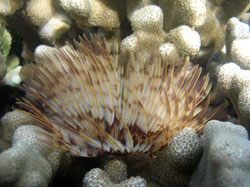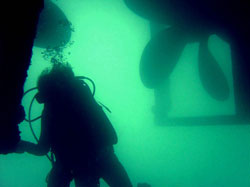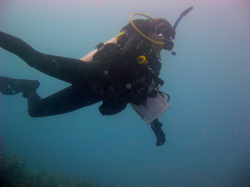
Reef Assessment and Monitoring Program Expediton Log – August 8, 2012
Ain't no Aliens on our Boat!
By: Megan Onuma & Carlie Wiener, COSEE Island Earth

The alien feather duster worm Sabellestarte spectabilis is established at Lisianski Island, Mokumanamana and Midway Atoll. Credit: S. Godwin
A serious effort is made to ensure that the Papahānaumokuākea Marine National Monument (PMNM) is kept as a pristine marine ecosystem. Part of this effort is keeping marine alien species at bay (invasive species that are not from Hawaiʻi); alien species directly compete with natives for resources, reducing native species and potentially affecting the entire food chain. This can be somewhat challenging with over 400 marine alien species found in the Main Hawaiian Islands; however, only 19 of these have been detected in the Northwest Hawaiian Islands. Most of these species are found in low numbers except in altered habitats such as Midway Atoll.
Scott Godwin, chief scientist on our expedition also works very hard at preventing alien species from spreading and drastically changing the Northwestern Hawaiian Islands delicate coral reef ecosystem. Scott has been collaborating with ship crew to ensure that strategies to minimize the likelihood of transporting marine alien species are maintained. Ship traffic is the main mode of transport for marine alien species therefore an entire management effort is carried out under the Resource Protection Program at the Papahānaumokuākea Marine National Monument office.

A NOAA diver conducting a marine alien species vessel inspection for a vessel entry permit. Credit: S. Godwin
The majority of Scott's effort is put towards the prevention and spread of alien species. In order to ensure that this occurs, a strict permit system is in place that every person must undergo before entering Monument waters. All vessels are subject to a strict inspection and disinfection program. Marine invasive species experts like Scott, examine the ballast water (water placed in the ships ballast tank to keep the boat stable when traveling on the ocean) and biofouling (the buildup of marine organisms such as algae and small invertebrates on wet surfaces like the hulls of ships). Ballast water must be exchanged or treated and the hulls must be cleaned prior to approval. Not only are boats subject to hull cleanings and inspection, each diver on board the ships including the NOAA ship Hiʻialakai, undergo gear inspection. Scientists must soak their diving and research equipment in a disinfectant solution of either bleach or ammonia prior to entry into the Monument, and in between each atoll location. Lastly, monitoring and inventory of existing marine alien species is conducted through documentation of existing and new records. Early detection of new species is critical so that potentially introduced species can be characterized in terms of their geographic distributions and their mode of transport.
While marine invasive species are not the main objective of the RAMP 2012 expedition, divers are trained and always on the lookout for potential threats. If found, special permits allow the scientists to photo document the species of concern, make note of invasive species locations and abundance, and remove a sample for identification. So far, we have not had to implement this protocol, and hope to continue seeing pristine and healthy reefs as we travel up the Northwestern Hawaiian Islands chain.
Click here to go back to the Expedition Log.

